When Jonathan Ancer encountered Iona Hassan and Anna Kitlar at his local bike shop, he knew there was an epic adventure behind their sun-kissed faces. He was right. A day earlier, the pair had pedalled into Cape Town after 63 days of zigzagging 6,469 kilometres through seven African countries. He tells their story.
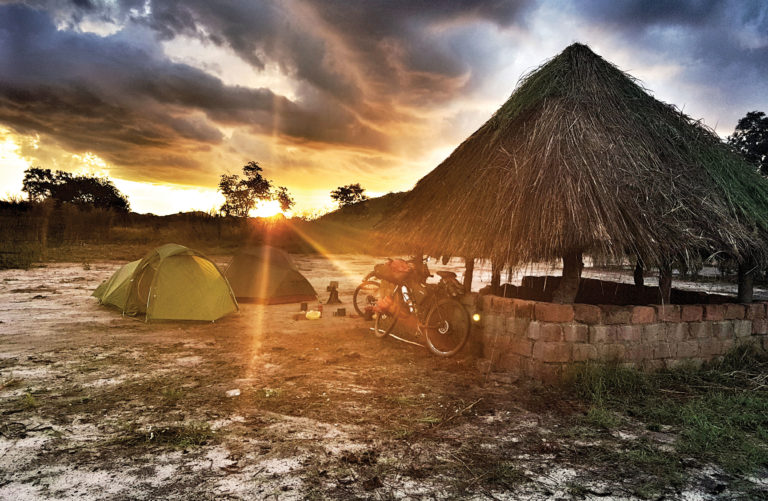
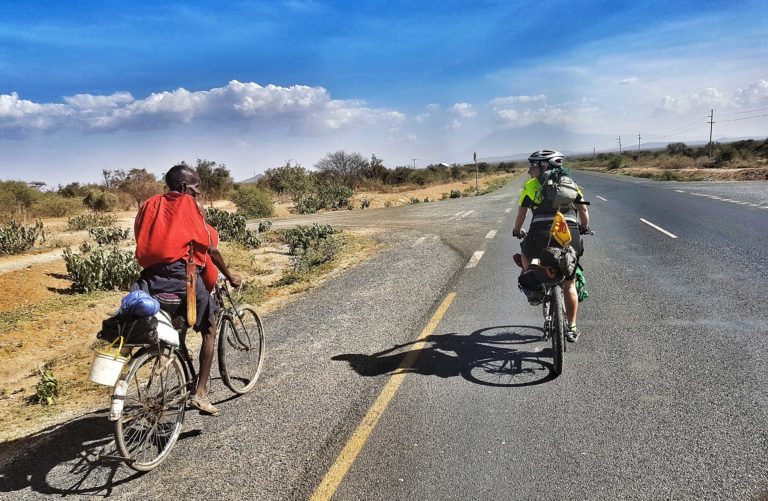
Riding with a Maasai companion near the Kenya/Tanzania border
It was 6am on Botswana’s Elephant Highway between Nata and Kasane. There was nothing to see but grassland savannah, a spectacular sunrise and the road disappearing into the horizon.
Iona Hassan wasn’t used to the crack-of-dawn starts but she and Anna Kitlar wanted to begin the day’s pedal before it became too hot.
A flock of birds flew into the air. Iona heard a roar. It was a lion. A shiver ran down her spine: her bike was painted in zebra stripes, and the lion was stalking her. She was now wide awake.
Iona didn’t have to outrun the lion; she just had to out-pedal Anna, but that never crossed her mind (so she claims). Instead, the intrepid travellers continued pedalling as if it was completely normal to cycle in the company of a hungry lion. Fortunately, the lion decided the birds would make a better meal.
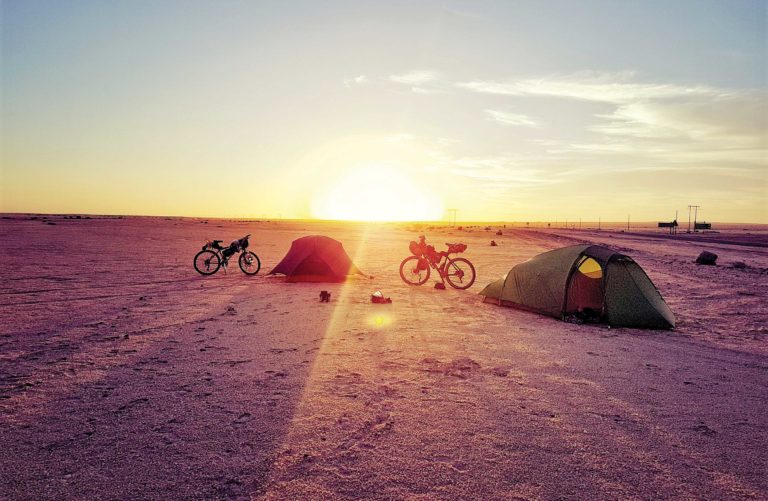
Desert camping along the C28 from Windhoek to Swakopmund.
With their hearts firmly in their mouths, #TeamZebra carried on, their bikes pointed south, destination Cape Town.
Five hours later, they saw a second lion.
This was on Day 33 of their adventure. Iona, who lives in the UK, and Anna, from Germany, had met face-to-face for the first time four weeks earlier at Dubai airport. Iona had found Anna after an online search for a companion to join her on an ambitious Kenya-to-Cape Town cycling safari. Anna, a bike-adventurer enthusiast, was also on a mission to raise awareness about climate change, and what better way to do this than by pedalling to drought-plagued Cape Town on a bike?
Iona, in turn, planned to raise funds for educational charity Inspire Malawi and Networks of Wellbeing, a mental-health organisation based in Scotland.

A chit-chat in northern Malawi
They flew to Kenya and began their cross-continental, wild-camping expedition. It was an ambitious adventure for Iona, a viola teacher and mountain-bike rookie, whose most daring bike trip to date had been a jaunt from Roscoff in France to Venice. Cycling through the benign countryside of Europe is one thing; Africa would be another kettle of goat-head horns altogether.
Anna, on a Ghost bike, had cycled solo through Asia and the Middle East before, so Iona was expecting some harsh off-road riding lessons and hoping to pass, if not with flying colours, then at least with zebra colours. The stripy decals for Ziggy, her Orange P7 bike, had been bought two weeks before leaving England. She’d wanted to get out of her comfort zone – but wasn’t expecting to be yanked out of it quite so forcefully.
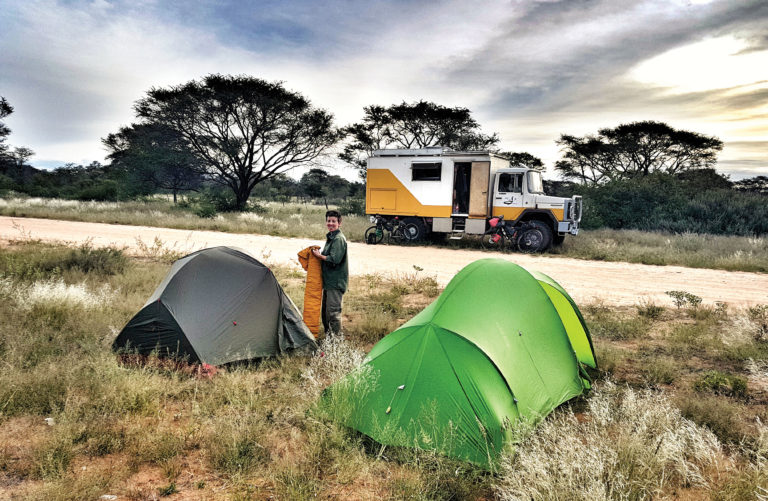
Camping in Botswana with new German friends they met along the way – who made them supper!
A day after their double-lion sighting, they encountered British tourists on the final night of a week-long safari to see lion. ‘They had paid a lot of sterling but hadn’t seen one, and we saw two lions on a fraction of the budget,’ says Iona. And that was exactly the point of their adventure.
‘It’s a cheap way to travel but it’s also about freedom,’ explains Anna. Because they were camping wild, they didn’t need to book accommodation but they did have to carry everything, a load of about 30 kilograms, including bikes.
‘We were treated with nothing but kindness on the road, eating in local villages and finding water along the way. We never felt unsafe; we never locked our bikes, except near the cities,’ says Iona.
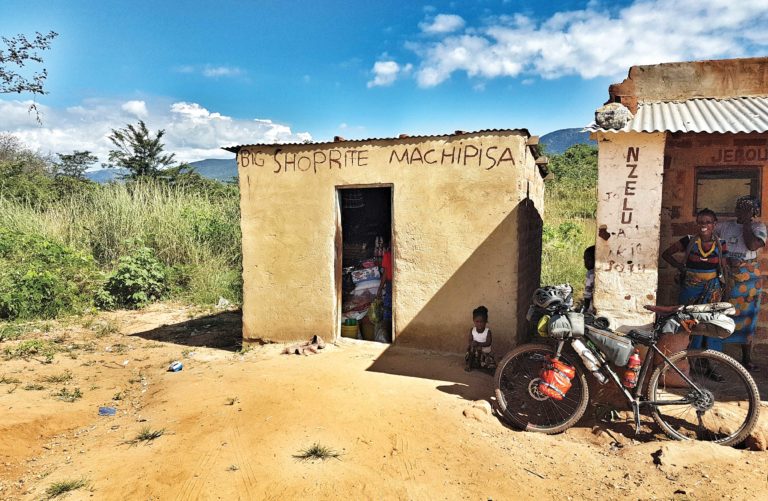
The local ‘Shoprite’ near Karonga on the Malawi border
After a day in the saddle they would find a spot to pitch their tents, sometimes just on the side of the road. Supper was pasta with cheese-sauce powder, tomato-soup powder or fresh tomatoes if they could find. Then they’d indulge in their nightly tradition of tea and biscuits at the campfire.
‘It’s a different form of travelling,’ says Anna. ‘Every single person you meet
will teach you something, if you allow them to.’ Often locals would accompany them. ‘A Maasai man cycled with us for 30 kilometres in Kenya,’ says Iona. ‘He didn’t speak much English but we had good fun anyway.’ In Zambia the pair were joined by a young deaf man for 70 kilometres. They communicated by making signs and texting.
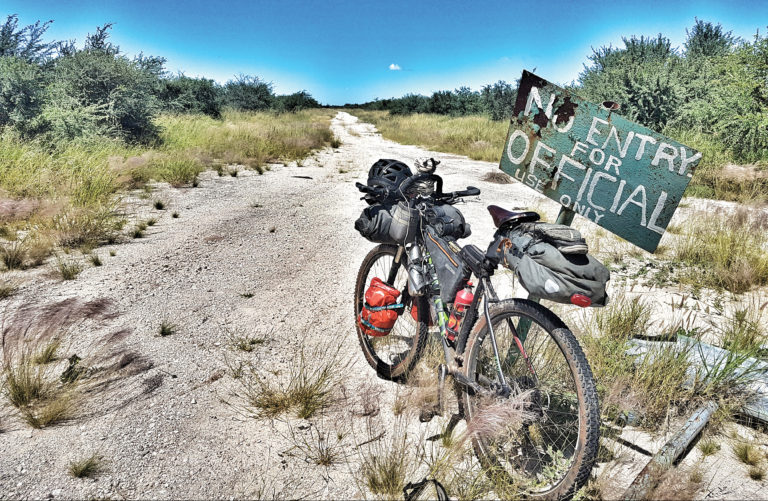
A temporary track in Zambia
One day in Malawi, they needed food and a villager went out of his way to find someone to prepare a meal for them. ‘A lovely woman cooked us five eggs each and sima, a dish made of maize flour. We took shelter in her little restaurant until a storm passed,’ recalls Iona.
It was tricky camping in Malawi because they couldn’t find a quiet spot and didn’t want to eat in front of people who had so little. One afternoon, just before sunset, they started a long climb, only reaching the top after dark. But a woman took them in to stay with her. ‘It’s heart-warming to experience this kindness in one of the world’s poorest places,’ says Anna.
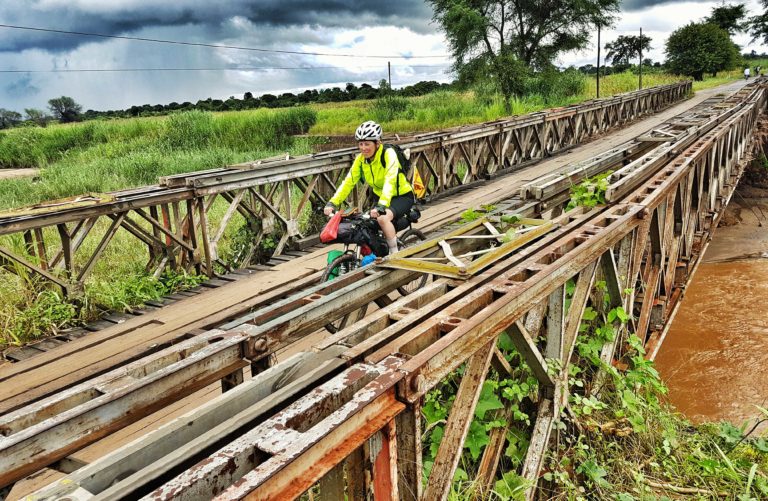
In Africa, if you can cross it, then it qualifies as a bridge. This gem was near Salima in Malawi.
While preparing for the trip, Iona had sketched a rough route from Africa’s east coast to its southern tip, via Kenya, Tanzania, Malawi, Zambia, Botswana and South Africa. But their golden rule was to let the road surprise them. ‘You need to be flexible and have faith it will work out,’ says Anna. ‘We never knew where we were going to sleep, what we were going to eat, which road we were going to take … we roughly knew the direction, but we were happy to take detours.’
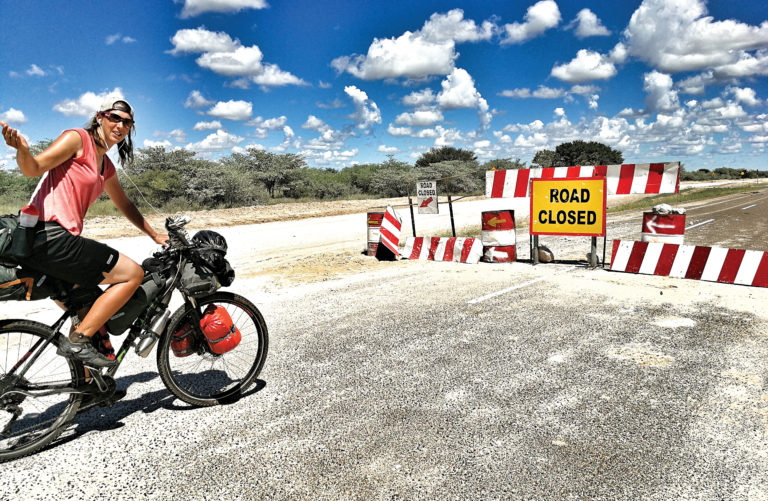
Road blockages were no problem on two wheels in Botswana.
They weren’t tourists, they were detourists. And this philosophy resulted in the best days of their adventure.
‘Approaching Nata in Botswana there was a severe headwind towards Gaborone but a lovely tailwind to Namibia. So we let the tailwind blow us to Namibia. It was absolutely the best decision of the whole trip. Namibia is one of the least populated countries so there is masses of space, good wild camping and traffic-free roads.’
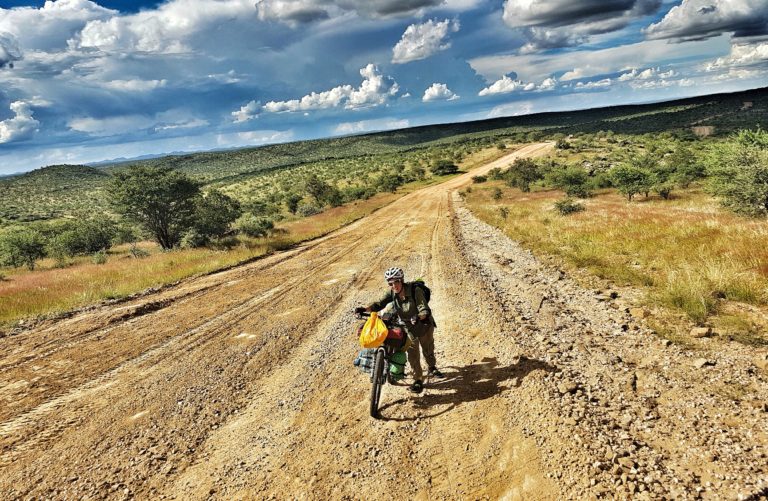
The Bosua Pass from Windhoek to Swakopmund was one of the toughest sections of the entire journey – at times pushing the 30kg load was the only way up.
They crossed the Bosua Pass and camped under sparkling stars in the Namib Desert. The going was tough: about 400 kilometres of mountainous riding in the baking heat and, with few places to get rations, they had to carry enough food and about 12 litres of water each. ‘This was the most challenging period, and the most rewarding,’ says Iona.
Here they also saw humanity at its best. Motorists stopped to give them water, food and encouragement. On a particularly hot day, a motorist with a fridge in his car stopped to give them glasses of thirst-quenching, ice-cold lime-and-soda.
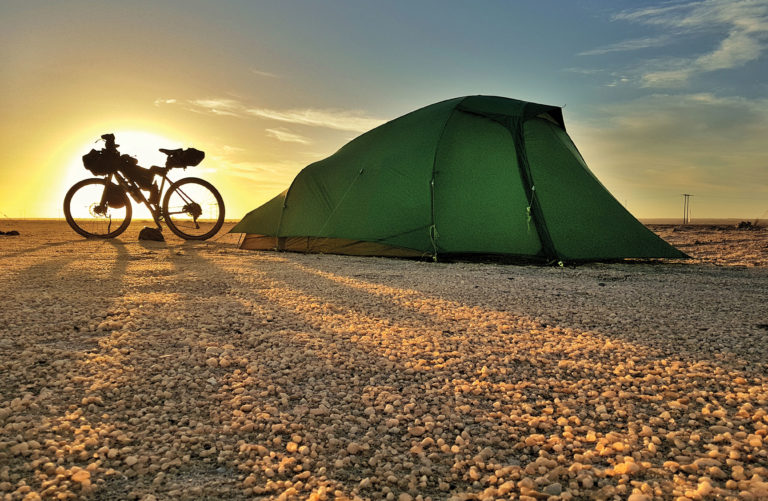
Desert camping along the C28 from Windhoek to Swakopmund.
For Iona, the great thing about bike-touring was getting the insider track on each country. ‘You travel through villages, meet people, support communities by buying supplies in the little shops. Yougo over every bump on the road, up massive mountains and fly down the other side. This helps you understand how the people live. You experience the heat, lack of water, incredible wildlife, all the things you miss when travelling from resort to resort in an air-conditioned bus. And you stay fit. There was never a moment I wanted to go home, not even when my legs went aaarrrggghhh!’
Their strategy was to focus on small milestones, not the final destination: just 20 kilometres to the gas station or the next chocolate. ‘The little rewards kept us going,’ says Anna. When they needed extra motivation, they set their sights on the nearest Wimpy. ‘We’re vegetarians and you don’t find many meat-free meals in Africa. But Wimpy has a delicious vegetarian burger.’
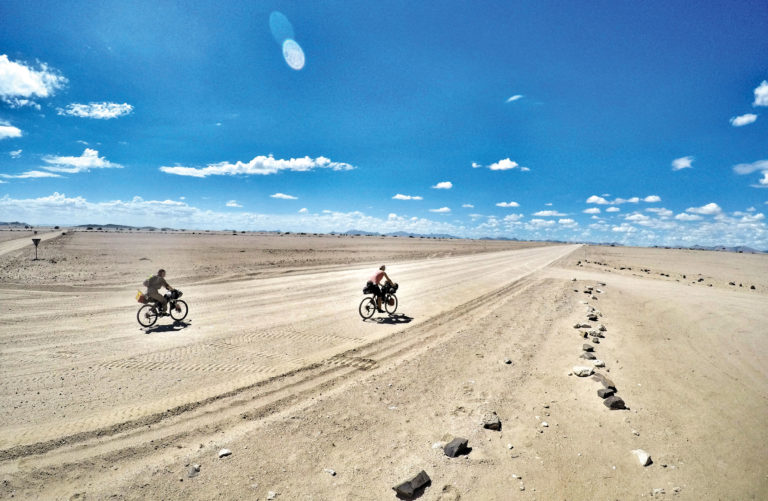
The oldest desert in the world (Namib) is an amazing place to camp; they loved cycling through Namibia – it’s not always obvious to see why!
Bike travelling has its disadvantages – like punctures. Iona’s tyres couldn’t handle the ubiquitous goathead thorns, although Anna didn’t have a single puncture on her Schwalbe Marathon Plus tyres.
They also had to navigate stretches of road that had been washed away. ‘The heavy bike load made climbing tough and going down sketchy,’ says Iona, pausing at memories of white-knuckle, teeth-chattering descents.
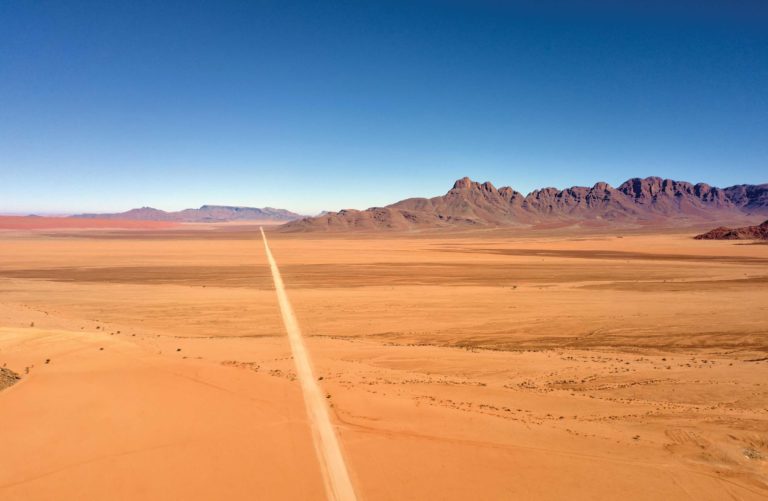
It’s not for agoraphobics, but after the terror of the Walvis Bay highway they yearned for deserted Namib roads like this.
But nothing was as scary as riding from Swakopmund to Walvis Bay, where they encountered a threat deadlier than lions, elephants and snakes combined: the extremely dangerous animals behind steering wheels. ‘I’ve cycled on many dangerous roads but that was the most treacherous,’ says Anna. ‘There’s no shoulder and constant traffic. The trucks pass centimetres away at high speed, the wind-rush pushing you off balance.’
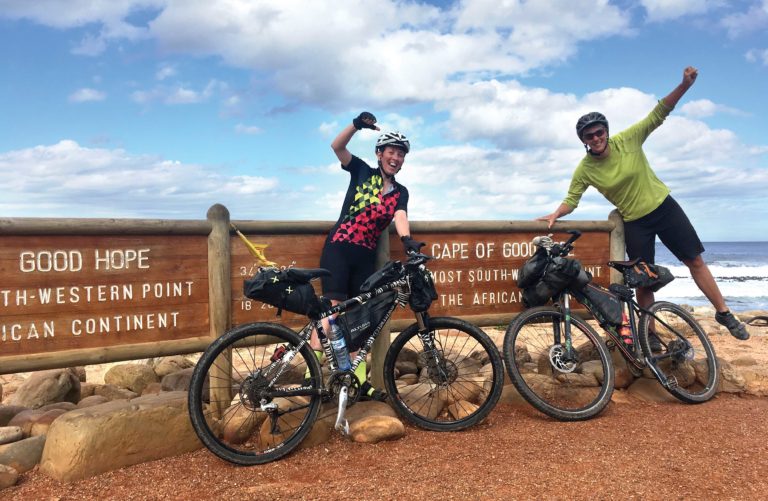
They didn’t let the small matter of Cape Agulhas spoil the ‘southern tip of Africa’ celebrations at Cape Point
About three weeks after entering Namibia, they crossed into South Africa. Tired and cold, still an hour from Bitterfontein (where they’d planned to spend the night), a woman pulled over and offered them cupcakes. It was just the boost they needed. The kindness of strangers throughout the trip reinforced their faith in humanity and their African odyssey was an antidote to all the negativity in the world, says Iona.
A few days later, #TeamZebra approached Cape Town, completing an epic, two-month journey. Table Mountain loomed into view. ‘Yeah, that was emotional,’ says Iona. ‘I shed a tear or two.
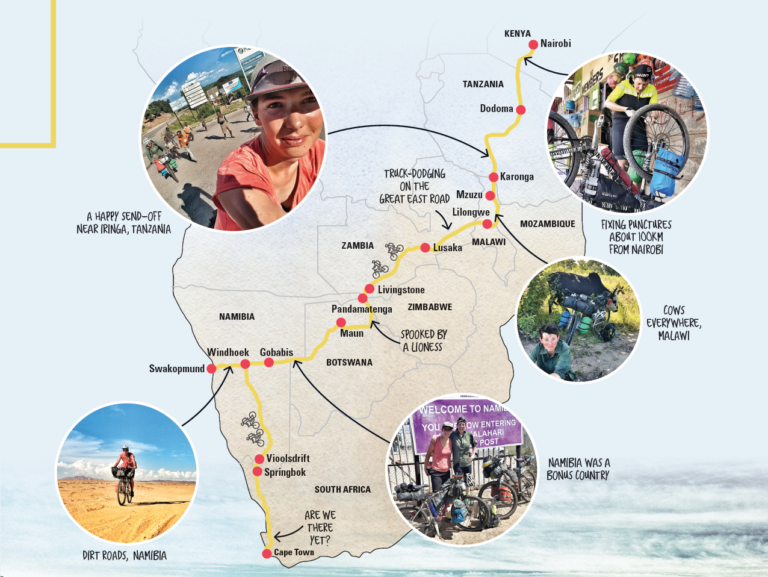
Plan your trip
Getting there
SAA and Kenya Airways fly from Joburg or Cape Town to Nairobi, from around R6 300 pp. SAA transports bikes free.
When to go
They chose the end of the rainy season from late February to the end of April; there is still some rain about but the temperatures are milder, around (25°C).
Need to know
Register with Warmshowers.org, a hospitality exchange network for bike tourists. You’ll meet lovely people who’ll offer a bed and a warm shower. Navigate using Maps.me, a free app used by cycle tourists who bookmark hotels, hostels and shops so travellers can find them easily. Use it on flight mode to save battery power. Don’t underestimate goathead thorns; they’re sharp and they’re everywhere, so use robust tyres.
Guard against heat stroke by drinking lots of liquid. And check your water bottles regularly for mould. Methylated spirits can be bought
in most towns so an alcohol stove is good; a wood stove is also brilliant
as wood is abundant. Namibia is a fantastic place to cycle tour; camp at the truck rest areas where there are picnic tables, here and in Botswana (but use your discretion regarding safety). It’s easy to buy data top-ups in each country. Carry extra biscuits and tea bags as gifts for people you meet.
Stay here
In addition to mostly wild camping, these are recommended spots:
Tanzania A basic room/bathroom just before the Mtera hydroelectric dam was the only place for miles around.
Malawi The Beach Chamber Motel in Karonga is a great setting (on Lake Malawi) and it has cold beer. Find it on Facebook. You can also camp on many beaches along the shore of Lake Malawi.
Zambia Livingstone Backpackers is a good, chilled base for visiting Victoria Falls, and close to all amenities. There’s a pool, communal kitchen and laundry facilities livingstonebackpackers.com
Botswana Panda Rest is the first campsite on the Elephant Highway, in a great setting with a bar where food is served. Camp or stay in a rondavel stay-botswana.com
Namibia Only camp in the Namib Desert if you are well prepared – and leave no trace. In Windhoek, go to Chameleon Backpackers and Guesthouse. chameleonbackpackers.com South Africa Thornbay Accommodation in Doringbaai on the West Coast has a beautiful setting, good rates and is self-catering doringbaai-accommodation.co.za
Eat and drink
Stock up on supplies in towns as village shops often sell only biscuits, fizzy drinks and (usually) water. Buy unsweetened doughnuts (vetkoek) at the side of the road in Tanzania and Malawi. ‘Chips mayai’ (an omelette with chips inside) is magnificent and found throughout Tanzania. Most Spar supermarkets have a water machine that recycles waste water – it’s cheaper to fill up from these than buying bottled water (it’s safe to drink and also environmentally friendlier). Or fill up at taps in service stations. They took water purification tablets but never used them, preferring to use common sense. Ask local people where to get food; often they’ll take you to someone who will cook a meal for you. This will cost around R25 to R90 in rural areas, more in towns but under R150 a meal. Maps.me is also great for finding food stops.
What it costs
Their average daily budget was R130 each (less some days or more when they stayed in guest houses due to rain or needing a rest). The entire trip cost R13 000 each, excluding flights.
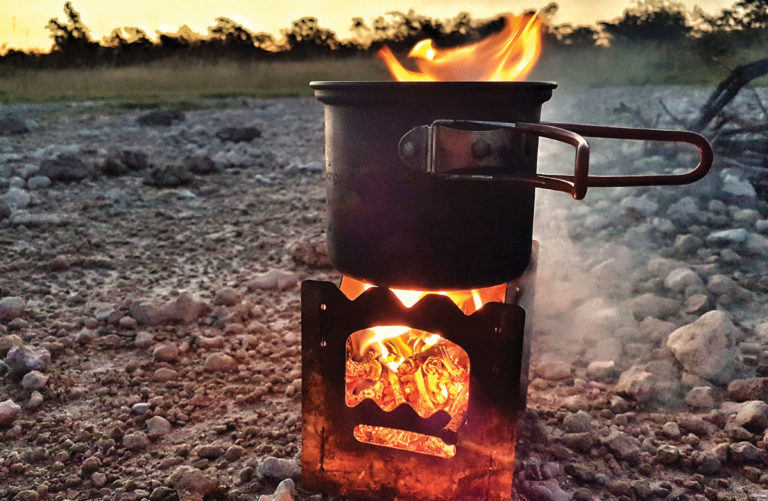
What they carried
Food: oats porridge, honey, peanut butter, crackers, pasta, cheese and tomato powder sauces, 5L water each.
Gear: stoves (wood and spirit), tents, Thermarest sleeping mats, battery chargers, backup battery packs.
Clothes: tops with sleeves, T-shirts, cycling shorts, a waterproof jacket.
Toiletries: wet wipes, first-aid kit, sunscreen, insect repellent.
Bike spares: bottom brackets, spokes, inner tubes, puncture repair kit, pump, quick links, multi-tool, tyre levers, chain whip, cable ties.
Text: Jonathan Ancer
Images: Iona Hassan and Anna Kitlar
You may also like
Related Posts
Whether you’re in a two-person hiking tent eye-balling the peaks or a full caravan in...
read more
Gabrielle Jacobs forsakes the Breede Valley’s winelands for some Cape nature at Vrolijkheid Nature Reserve,15km...
read more
A new guided hike in the Western Cape known as the 16 Mile Beach Challenge...
read more